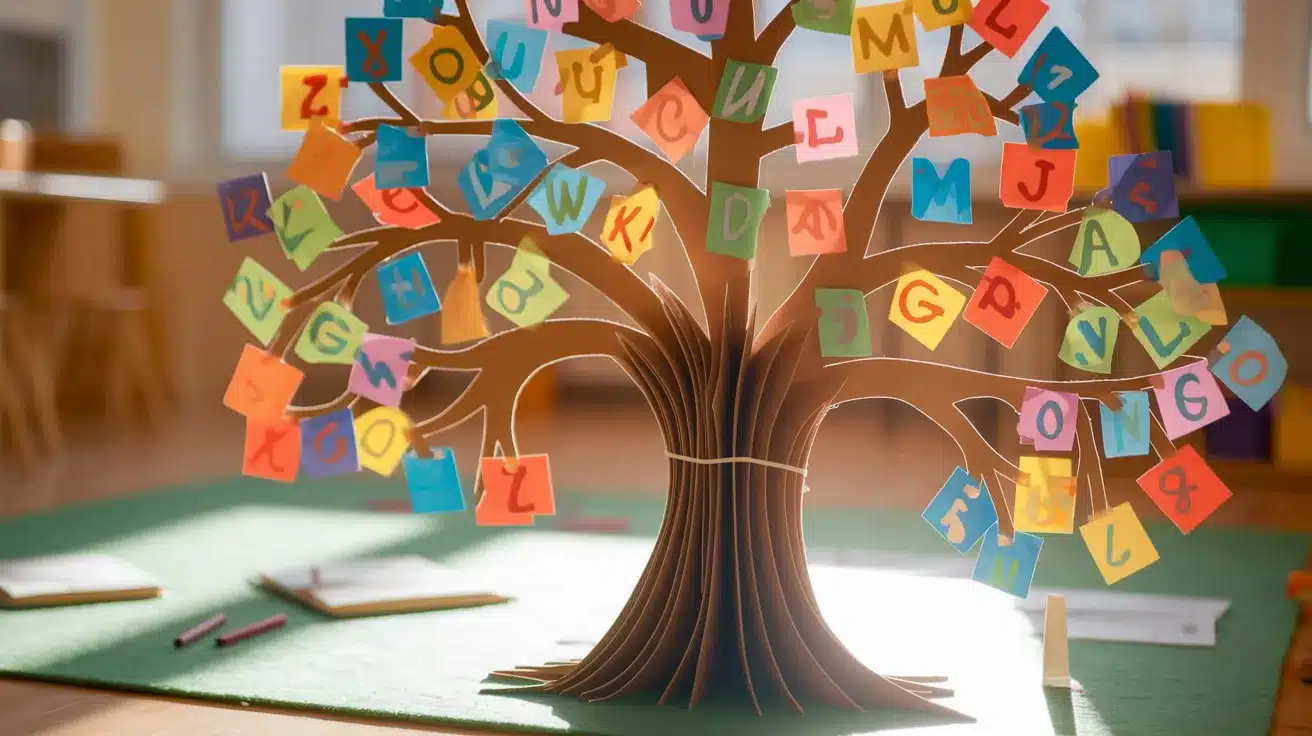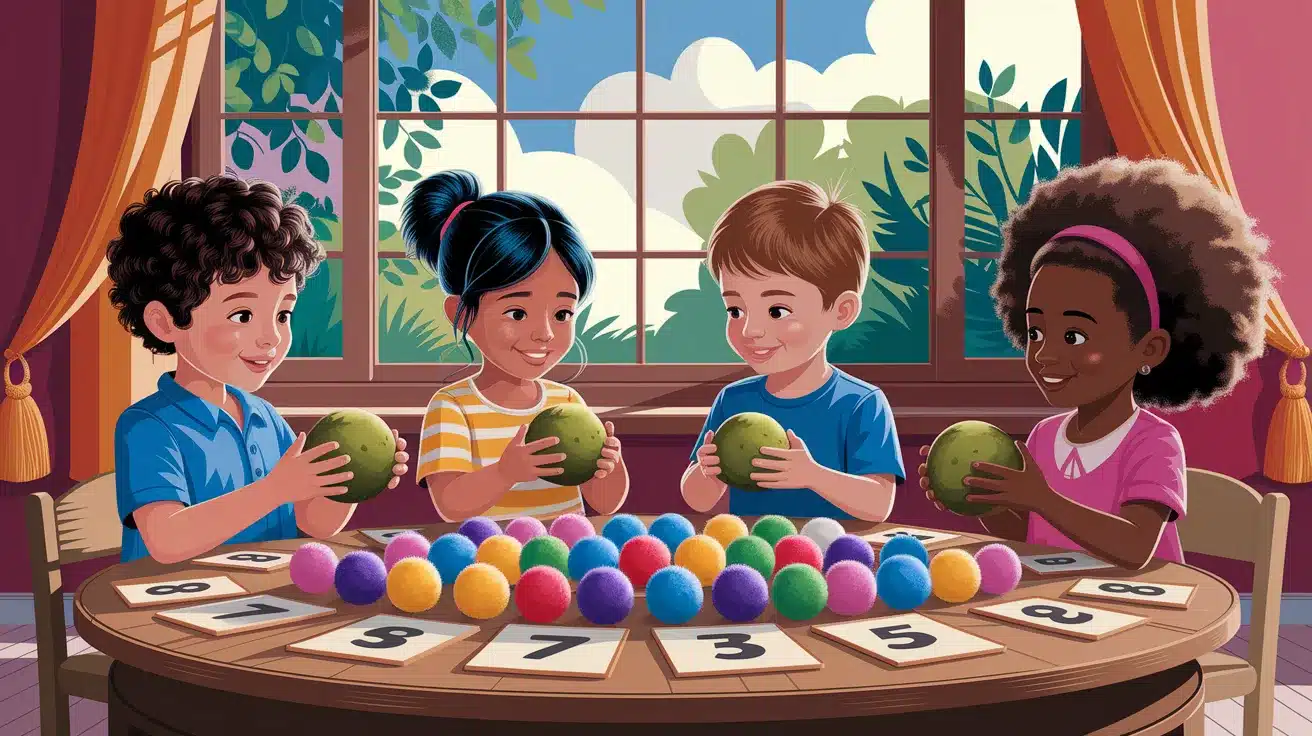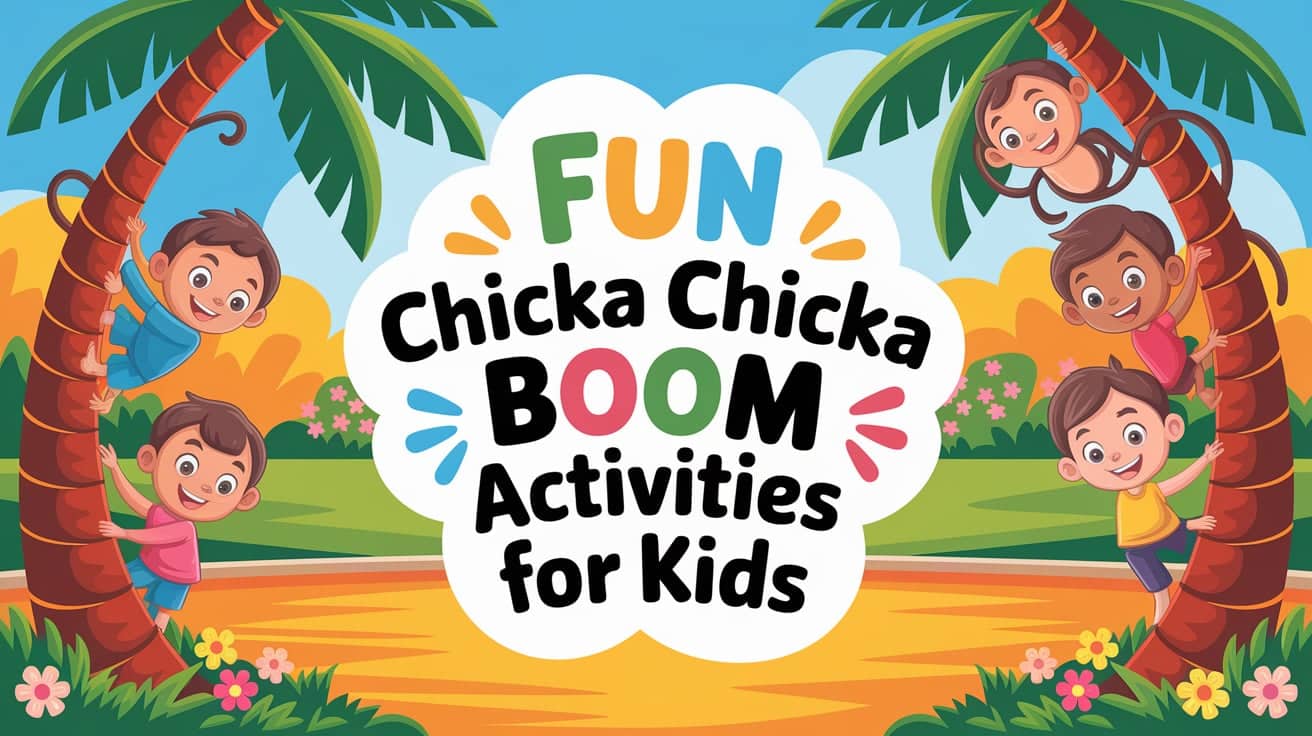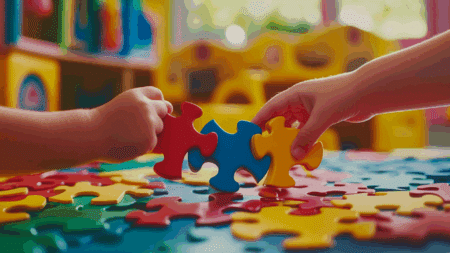Chicka Chicka Boom Boom is a book that helps young children learn the alphabet.
The story shows letters racing up a coconut tree, making learning fun through its catchy phrases and bright pictures.
This popular book engages children while teaching them to recognize letters and their sounds in a fun way.
Hands-on activities based on the book help children learn even better. When kids touch letters, create crafts, or act out the story, they remember what they know.
These interactive experiences develop important skills like letter recognition and finger coordination for writing.
In this blog, we’ll learn more about Chicka Chicka Boom Boom activities and some of them to implement in your classroom!
What are Chicka Chicka Boom Boom Activities?
Chicka Chicka Boom Boom is a fun story about lowercase letters racing to climb a coconut tree. When too many letters climb up, the tree bends, and all the letters fall. Then, the uppercase letters (like parents) come to help.
This simple story helps kids learn letter names and shapes while they enjoy the repeated phrase “Chicka, chicka, boom, boom! Will there be enough room?”
Activities based on this book help children learn many skills as they play. Kids practice recognizing both uppercase and lowercase letters, putting the alphabet in order, and hearing the sounds in words. They also develop hand strength for writing when they trace letters or make crafts.
Some activities include counting letters, learning colors, and building vocabulary. These fun activities make learning feel like play while building important skills for reading and writing.
15 Fun “Chicka Chicka Boom Boom” Activities
1. Letter Tree Craft

Create a fun coconut tree craft inspired by Chicka Chicka Boom Boom using easy-to-find materials. Cut out a tall brown trunk and branches from construction paper, then add green paper leaves at the top to make it look like a palm tree.
Give children alphabet letters that they can glue or tape onto the tree, starting from the bottom and climbing up, just like in the story. While they place each letter, ask them to say its name and sound it out loud.
This activity helps kids learn their letters while also practicing using their fingers to handle small objects – an important skill for writing later. You can make the craft more fun by adding real or paper coconuts, or turn it into a learning game by having them put letters in ABC order.
Children love having their letter tree to play with and can use it to retell the story or practice alphabet recognition whenever they want.
2. Coconut Counting

Gather small coconut-shaped objects like wooden beads, brown pom-poms, or paper cutouts that children can easily hold and move around. Set these “coconuts” out with number cards or a simple worksheet showing numbers.
Children count the coconuts one by one, saying each number as they touch each object, which helps them understand that each number matches exactly one item.
Once children master basic counting, you can create more challenging activities. They might sort coconuts into groups, match specific numbers of coconuts to number cards, or use them for simple addition and subtraction.
For instance, ask, “If we have 3 coconuts and add 2 more, how many do we have now?”
Children can physically move the coconuts to find the answer. This hands-on approach makes abstract math concepts much easier for young learners to understand and remember while connecting math learning to a story they already enjoy.
3. Alphabet Playdough Letters

Give children different colors of playdough and show them how to roll it out flat on a clean surface. They can then use alphabet cookie cutters to press out letter shapes or shape the letters with their own hands by rolling the dough into long “snakes” and bending them into letter forms.
As children create each letter, ask them to name it and make its sound, rooting the connection between the letter’s shape and its role in language.
They might also form both uppercase and lowercase versions of each letter to understand the relationship between them.
This hands-on activity strengthens fine motor skills as children press, roll, and shape the dough while also building letter recognition in a fun way.
The three-dimensional nature of the playdough letters helps children understand letter shapes from multiple angles, which is especially helpful for young learners who can benefit from multisensory ways of studying.
4. Magnetic Letter Tree

Make a simple tree on a metal cookie sheet or magnetic board. Draw a brown trunk and green leaves, or cut them from paper and tape them on. Give the children magnetic alphabet letters to stick on the tree.
The magnets will keep the letters in place, just like the letters climbing the tree in Chicka Chicka Boom Boom.
Kids can have fun putting letters on the tree while saying each letter’s name and sound. Turn it into a game by asking them to find specific letters or have them put letters in ABC order.
You can also ask them to see the letters in their name to put on the tree.
This activity helps children learn their letters while they play and practice using their fingers, which is important for learning to write later.
5. Letter Scavenger Hunt

Hide alphabet letters around your classroom for a fun scavenger hunt. You can use plastic letters, foam letters, or just paper letter cards. Make sure to hide them in places that are safe and accessible for young children – under pillows, behind books, or on low shelves.
Before starting, create a simple coconut tree on a poster board or use a felt board where children can place the letters they find.
When you’re ready to begin, explain to the children that the letters from the book are hiding and that they need to find them. As each child finds a letter, have them say its name and sound before placing it on the tree.
This activity gets children moving while practicing letter recognition. You can make it more educational by having them find letters in alphabetical order or more exciting by using a timer or playing music while they search.
The combination of physical movement and letter learning keeps children engaged and helps them remember their ABCs better.
6. Name Recognition Tree

Create a classroom tree display where each child can add their name to the branches. Start with a large tree shape on a wall or bulletin board, using brown paper for the trunk and green paper for the leaves.
Cut out colorful letters for each child’s name, or have older children cut out their letters. When children add their names to the tree, have them say each letter aloud as they attach it to a branch.
This personal connection to the Chicka Chicka Boom Boom story helps children recognize letters in a meaningful context—their own names!
To extend the activity, have children identify which friends’ names start with the same letter as theirs or count the number of letters in different names.
7. Coconut Sensory Bin

Fill a big, flat container with things that feel like the beach from Chicka Chicka Boom Boom. You can use brown rice for sand, real coconut pieces, or small brown balls that look like coconuts. Hide alphabet letters all through this mixture.
You can use foam letters, plastic letters, or even just cards with letters on them.
Kids love to dig their hands through the bin to find the hidden letters. When they see a letter, ask them to tell you its name and sound. They can place the letters they find on a small paper tree nearby or sort them by color or type.
This fun activity lets children touch, see, and maybe even smell the materials while they learn.
Playing with the sensory bin helps children remember their letters better and gives them practice using their fingers, which helps them prepare for writing.
8. Alphabet Matching Cards

Make simple matching cards to help children connect uppercase and lowercase letters. Create cards by cutting paper into even squares and writing one letter on each card – some with uppercase letters and others with their lowercase matches.
You can color-code the cards (all uppercase cards in one color, lowercase in another) or add small pictures of items that start with each letter to give children an extra hint.
Children can spread the cards face up and find matching pairs or play a memory game by turning them face down and taking turns flipping two cards to find matches.
When they see a matching pair, have them say the letter name and sound.
This activity helps children understand that each letter has two forms that make the same sound. It’s a simple yet effective way to reinforce alphabet knowledge while building memory skills and letter recognition.
For children just learning letters, start with just a few pairs and gradually add more as they become more confident with letter recognition.
9. Alphabet Water Color Art

Give children large paper with alphabet letters lightly drawn or printed on it. Let kids paint and decorate the letters using watercolors, finger paints, or other art supplies.
As they paint each letter, talk about its name and sound.
Children enjoy making the letters come alive with bright colors and patterns. This helps them remember letter shapes better because they’re actively engaging with each form.
You might focus on painting letters in bright colors similar to those in the book’s illustrations. You can also create a class alphabet book by collecting everyone’s painted letters.
This activity builds both letter recognition and fine motor skills while giving children a chance to express themselves artistically.
The finished artwork makes a great classroom display or take-home project that reminds children of the alphabet they’re learning.
10. Chicka Chicka Boom Boom Dance

Turn alphabet learning into an active experience with this movement activity inspired by Chicka Chicka Boom Boom. Start by reviewing the story together, paying special attention to how the letters climb up the tree and then come crashing down with a “Boom boom!”
Then create simple movements to represent different parts of the story.
Children can stand tall with arms stretched upward when letters climb the tree, sway side to side when the tree bends, and then carefully tumble or fall to the ground for the “boom boom” part. Play music with a steady beat and have children move around the room, acting out the story.
You might give each child a letter to wear or hold, and when their letter is called, they can do their special movement.
This activity combines gross motor development with alphabet learning, helping children connect letters with physical actions.
It’s especially beneficial for active learners, who remember concepts better when movement is involved. The dance also builds listening skills as children wait for their letter’s turn and follow the story’s sequence.
11. Alphabet Relay Race

This active game gets children moving while practicing their alphabet knowledge. Set up a starting line on one side of your play area and place a large tree poster or board on the opposite side. Scatter alphabet letters on a table or in a bin near the starting line.
Divide the children into small teams and have them line up at the starting point.
When you say “Go,” the first child from each team runs to the table, finds a specific letter you call out (or the next letter in alphabetical order), then runs to place it correctly on the tree.
After putting their letter, they run back and tag the next teammate, who repeats the process.
Teams can work on completing the whole alphabet in order, or you can assign each team different letter groups.
The physical movement makes learning exciting while reinforcing letter recognition and sequence. This activity is perfect for burning energy while building important skills.
12. Alphabet Yoga

Create a space where children can stretch out and move freely. Demonstrate how to use their bodies to form letters—for example, standing straight with arms overhead in a “Y” shape for the letter Y or bending forward with straight legs and arms reaching toward the floor to make an upside-down V for the letter A.
Start with just a few easy-to-form letter poses, like T (standing with arms stretched wide), L (standing on one leg with the other extended to the side), and O (making a circle with arms above the head).
As children move into each pose, have them say the letter name and its sound.
The yoga poses also improve balance, coordination, and body awareness while providing a calming activity that helps children focus.
For added fun, you can create a simple sequence of letter poses that tells a mini-story, giving children a chance to move from one letter to the next in a flowing pattern.
13. Alphabet Hopscotch

Create a fun outdoor activity by drawing a hopscotch pattern with chalk on the ground, but instead of numbers, write alphabet letters in each square.
If you’re playing inside, you can make the game using masking tape on the floor or by laying out paper squares with letters written on them.
Try arranging letters in alphabetical order or mix them up for different levels of challenge. Children take turns tossing a small stone or beanbag onto the hopscotch grid, then hop through the pattern, skipping the square where their marker landed.
As they hop on each letter, they should say its name out loud. When they reach the end, they turn around and hop back, picking up their marker when they reach it.
This game gets kids moving while they practice letter recognition and sounds. The physical movement and fun competition make it a popular way to reinforce alphabet knowledge while developing balance and coordination.
14. Coconut Letter Sorting with Colored Cups

Set up a simple sorting activity using different colored cups labeled for specific letter categories. You might use green cups for vowels, blue cups for consonants, red cups for uppercase letters, and yellow cups for lowercase letters.
Make labels with pictures or words to help children remember which cup is for which type of letter.
Place a collection of letter shapes (foam letters, magnetic letters, or laminated letter cards) in a central container decorated to look like a coconut.
Children take turns picking a letter from the “coconut,” naming it, and deciding which cup it belongs in. For example, a lowercase “a” might go in both the vowel cup and the lowercase cup, creating an opportunity to talk about how letters can belong to multiple categories.
This activity helps children recognize patterns in the alphabet while practicing letter identification. The colorful cups make sorting visually appealing, and children enjoy the satisfaction of categorizing letters correctly.
15. Chicka Chicka Boom Boom Bingo

Create a fun alphabet game by making bingo cards with letters instead of numbers. Each card should have a grid with different letters arranged randomly in the squares.
You can customize the size based on children’s age and skill level – maybe a 3×3 grid for younger children or a 5×5 grid for older ones. Make multiple cards with different letter arrangements so each child has a unique card.
To play, call out letters one by one, pulling them from a bag or spinning a letter wheel. Children listen carefully and mark the letter on their card if they have it – using tokens, stickers, or small “coconuts” (brown pom-poms).
The first child to complete a row, column, or diagonal line calls out “Boom Boom!” and wins that round.
This game builds letter-recognition skills while adding excitement through friendly competition. It also helps children practice listening skills and attention as they monitor their cards.
Conclusion
Chicka Chicka Boom Boom offers a way to make learning the alphabet fun and exciting for young children.
Through creative activities like letter crafts, sensory play, movement games, and interactive challenges, kids can learn letters in ways that go beyond traditional teaching. These activities help children build important life skills.
The story’s bright illustrations capture their attention, making it an ideal way to introduce the alphabet.
What’s great about these activities is that they blend learning with play. The best part is that the activities can be easily adjusted for different skill levels, making them ideal for both classroom settings and at-home learning.
If you’re curious to keep learning, don’t stop here! Check out more of our fun blogs for more activity ideas, tips, and ways to help your child learn!




